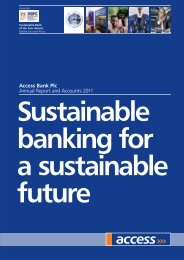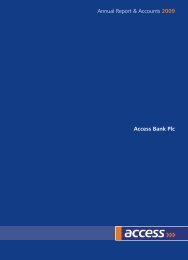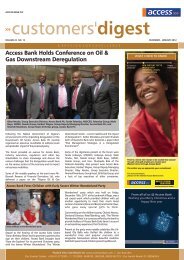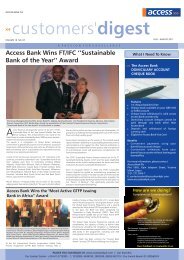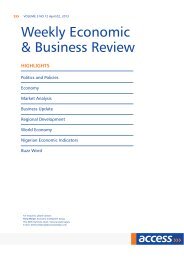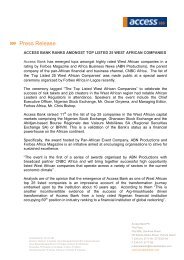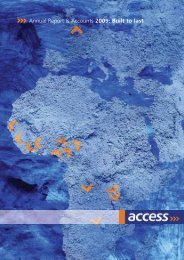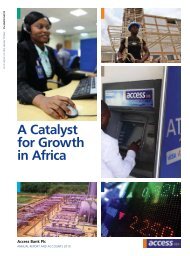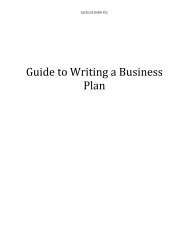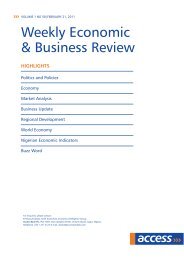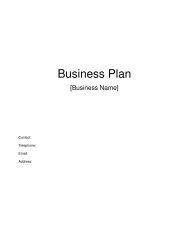You also want an ePaper? Increase the reach of your titles
YUMPU automatically turns print PDFs into web optimized ePapers that Google loves.
[Type text] Page 1
<strong>Access</strong> Economic <strong>Quarter</strong>ly Q2 <strong>2011</strong>
Table of Contents<br />
The Nigerian Economy<br />
GDP Growth: Remained Poised for Further Expansion<br />
Monetary Policy: Quantitative Tightening to Counter Inflation<br />
Inflation: Expectation Still on the Upside<br />
External Reserves: Buffer Likely to Rise With Current Favourable Oil<br />
Fundamentals<br />
Exchange Rate: Commitment to a Stable Currency Takes Priority<br />
Crude Oil Price: Upside Force Weakened by Global Macroeconomic<br />
Sentiments<br />
Stock Market: Is a Rebound Lurking?<br />
Interest Rates: Tight Liquidity and MPR Hiking Cycle May Distort Domestic<br />
Rates<br />
<strong>2011</strong> Budget: Reawakened Need for Fiscal Discipline<br />
Public Debt: Tendency for a Further Uptrend Still Wide-spread<br />
Financial Sector: Targeted Reforms to Strengthen the System<br />
Socio-Economic SWOT Analysis<br />
Revised Outlook for Q2 <strong>2011</strong> and the Rest of <strong>2011</strong><br />
<strong>Access</strong> Economic <strong>Quarter</strong>ly Q2 <strong>2011</strong>
Q1 08<br />
Q2 08<br />
Q3 08<br />
Q4 08<br />
Q1 09<br />
Q2 09<br />
Q3 09<br />
Q4 09<br />
Q1 10<br />
Q2 10<br />
Q3 10<br />
Q4 10<br />
Q1 11<br />
Q2 11<br />
Q3 11e<br />
Q4 11e<br />
%<br />
The Nigerian Economy<br />
GDP Growth: Remained Poised for Further Expansion<br />
Real gross domestic product (rGDP) is projected to grow by 7.93% in Q2 <strong>2011</strong><br />
according to interim numbers from the National Bureau of Statistics (NBS). This<br />
figure falls below the double digits target set by the country’s economic planners to<br />
meet with the nation’s desire to be ranked amongst the world’s top-20 economies by<br />
2020.<br />
Real GDP Growth Rate<br />
9.0<br />
8.5<br />
8.29<br />
8.46<br />
8.0<br />
7.5<br />
7.0<br />
7.10<br />
7.45<br />
7.36<br />
7.43<br />
7.92<br />
6.5<br />
6.0<br />
5.5<br />
5.0<br />
4.5<br />
4.64<br />
5.01<br />
4.0<br />
Source: NBS<br />
The non-oil sectors continued to remain the major driver of overall growth, with<br />
agriculture, wholesale and retail trade, and services contributing 2.39%, 2.04% and<br />
2.08%, respectively.<br />
The combined growth total in the non-oil sectors is 8.46% while the oil sector output<br />
growth is estimated at 2.90%. The outlook for <strong>2011</strong> generally looks good,<br />
underpinned by the favourable conditions for increased agricultural production,<br />
encouraging outcomes of the banking sector reforms and measures to channel credit<br />
to the real economy, as well as growing emphasis on the development of non-oil<br />
sectors and key infrastructure.<br />
<strong>Access</strong> Economic <strong>Quarter</strong>ly Q2 <strong>2011</strong>
2010 GDP Contribution<br />
1.88%<br />
4.92%<br />
4.49%<br />
3.85%<br />
2.16%<br />
0.97% 0.37%<br />
Agriculture<br />
Wholesale & Retail<br />
44.08%<br />
Oil & Gas<br />
17.11%<br />
Telecommunication<br />
Manufacturing<br />
Finance & Insurance<br />
20.18%<br />
Building & Construction<br />
Real Estate<br />
Business and other services<br />
Solid Minerals<br />
Source: NBS<br />
On an aggregate basis, the economy measured by rGDP is expected to grow by<br />
7.98% in <strong>2011</strong> up by 0.13% over the figure recorded in year 2010. The non-oil<br />
sectors are expected to continue to drive the Nigerian economy in <strong>2011</strong>, with<br />
agriculture projected to grow at 5.68% in <strong>2011</strong>.<br />
Monetary Policy: Quantitative Tightening to Counter Inflation<br />
The Central <strong>Bank</strong> of Nigeria (CBN) in the period under review adopted a quantitative<br />
tightening monetary policy stance. This was consistent with the need to address<br />
inflationary expectations of the anticipated excessive liquidity and pressure on<br />
foreign exchange market. At its 3rd meeting in <strong>2011</strong>, held 23rd - 24th May <strong>2011</strong>, the<br />
Monetary Policy Committee (MPC) raised the Monetary Policy Rate (MPR) by 50<br />
basis points to 8% citing concerns of expected increase in budgeted expenditure on<br />
critical government projects, implementation of new minimum wage and possible<br />
withdrawal of petroleum subsidy.<br />
<strong>Access</strong> Economic <strong>Quarter</strong>ly Q2 <strong>2011</strong>
July<br />
Aug<br />
Sept<br />
Oct<br />
Nov<br />
Dec<br />
Jan<br />
Feb<br />
Mar<br />
April<br />
May<br />
%<br />
Monetary Policy Rate<br />
8.5<br />
8.0<br />
7.5<br />
7.0<br />
6.5<br />
6.0<br />
5.5<br />
5.0<br />
Q3 Q4 Q1 Q2<br />
2010 <strong>2011</strong><br />
Source: CBN<br />
The MPC stressed the importance of continuing structural reforms and infrastructural<br />
development to enhance domestic production - one of the measures to reduce the<br />
import bill and its pass-through inflation effects.<br />
The Committee also raised cash reserve requirement (CRR) to 4% from 2% as part<br />
of its quantitative tightening measures. This took effect from June 8, <strong>2011</strong>, to directly<br />
impact liquidity in the system. Its pass-through effects on speculative demand for<br />
foreign exchange are revealed by data which shows significant decline after the CRR<br />
was raised by 100 basis point at the January MPC.<br />
Although the fiscal authorities have declared their intention to fiscal consolidation,<br />
analysts are expressing concerns on the need to reduce the systemic pressure<br />
exerted by rising government borrowings.<br />
Nevertheless, a further possible increase in the MPR is still anticipated. This is<br />
predicated on the evidence of increasing demand for dollars, removal of subsidies on<br />
imported petroleum products and rising international food and energy prices, which<br />
threaten to stoke up inflationary pressures in the coming months. This policy<br />
decision is also expected due to the need to correct the negative real interest rate<br />
which has in the last few years heightened the risk of disintermediation.<br />
<strong>Access</strong> Economic <strong>Quarter</strong>ly Q2 <strong>2011</strong>
<strong>2011</strong><br />
Jan Feb Mar Apr May June<br />
%<br />
Inflation: Expectation Still on the Upside<br />
The year-on-year headline inflation dropped to 10.2% in June from 12.4% in May,<br />
representing a 220 basis points fall. Food inflation also dropped to 9.2% from 12.2%<br />
in May <strong>2011</strong>. Core inflation at 11.5% was also lower than the 13% recorded in May<br />
<strong>2011</strong>. The fall in headline inflation was primarily due to decline in the prices of some<br />
food items & non-alcoholic beverages, imported food items, transportation, clothing<br />
& footwear housing and electricity/gas prices.<br />
Worried by rising inflationary pressure, the Monetary Policy Committee (MPC) raised<br />
the Monetary Policy Rate (MPR), for the third consecutive time, from 7.5% to 8% at<br />
its last meeting held May 23rd – 24th, <strong>2011</strong>. The Committee, which also lifted the<br />
Cash Reserve Requirement (CRR), had expressed its desire to check inflation which<br />
has stubbornly remained at double digits, to single digit.<br />
Inflation<br />
9.00 10.50 12.00 13.50 15.00<br />
Source: NBS<br />
Food Inflation Core Inflation Inflation (Y -Y)<br />
The CBN Governor, Lamido Sanusi expressed fears that rising government<br />
expenditure along with accelerating costs of imported food and unsubsidized fuel<br />
products may push up inflation, with the CBN facing an uphill task achieving its<br />
single-digit inflation target.<br />
<strong>Access</strong> Economic <strong>Quarter</strong>ly Q2 <strong>2011</strong>
$ Billion<br />
Jan<br />
Feb<br />
Mar<br />
Apr<br />
May<br />
Jun<br />
$/Barrel<br />
Although the approaching harvest season gives a basis for a positive outlook,<br />
inflation expectations remain high owing to the subsisting high fiscal spending<br />
(especially at the state level), recent increases in public sector wages, anticipated<br />
increase in power tariff, possible removal of subsidy on petroleum products, further<br />
liquidity injection due to AMCON activity and elevated global food and energy prices.<br />
External Reserves: Buffer Likely to Rise With Favourable Oil Fundamentals<br />
The Nation’s external reserves declined to US$31.88billion as at end Q2 from<br />
US$32.76billion at Q1 <strong>2011</strong>, a drop of 2.7%. The depletion in the reserves was due<br />
primarily to NNPC deductions for joint venture cash calls (JVCC) and petroleum<br />
subsidies.<br />
External Reserves & Bonny Light<br />
35.00<br />
30.00<br />
25.00<br />
20.00<br />
140<br />
120<br />
100<br />
80<br />
60<br />
40<br />
20<br />
0<br />
<strong>2011</strong><br />
External Reserves<br />
Bonny Light (Crude Oil) Price<br />
Source: CBN & OPEC<br />
Exchange Rate: Commitment to a Stable Currency Takes Priority<br />
The foreign exchange market remained relatively stable in the quarter under review<br />
owing to the deliberate policy of the CBN to increase supply to the market to<br />
maintain the exchange rate within a band of N150 +/- 3%, complemented by funding<br />
from autonomous sources.<br />
At the WDAS segment, the Naira/Dollar exchange rate opened at N151.52/US$ on<br />
April 1, <strong>2011</strong> and closed at N151.79/US$ on June 30, <strong>2011</strong>, representing a slight<br />
depreciation of 0.18% (or N0.27k). Also, interbank rates opened at N154.07/US$ and<br />
<strong>Access</strong> Economic <strong>Quarter</strong>ly Q2 <strong>2011</strong>
N/$<br />
closed at N152.10/US$, an appreciation of 1.28%. The premium between the rates<br />
at the WDAS and other segments of the market narrowed significantly towards the<br />
end of the review period.<br />
Exchange Rates<br />
161<br />
159<br />
157<br />
155<br />
153<br />
151<br />
149<br />
147<br />
145<br />
Jan Feb Mar April May June<br />
Q1<br />
Q2<br />
<strong>2011</strong><br />
Official Parallel BDC Interbank<br />
Source: CBN & FDMA<br />
The CBN is expected to continue to favour maintaining the Naira value, within its<br />
narrow band, with periodic adjustments to avoid running-down foreign reserves.<br />
Relatively strong oil prices—albeit likely to fall in Q4 <strong>2011</strong>—should allow the<br />
maintenance of this policy, although the CBN is likely to move towards greater<br />
liberalization of the currency markets once the recapitalization and consolidation<br />
process in Nigeria's financial sector is fully addressed.<br />
Even though Nigeria’s fiscal metrics and oil-revenue leakages place substantial<br />
pressure on the Naira, the recent lifting of the requirement for foreign investors to<br />
hold local-currency investments in government securities for at least 1 year is<br />
expected to attract new capital inflows and reduce pressure on the nation’s external<br />
reserves. Analysts anticipate a slight appreciation of the Naira in Q3 <strong>2011</strong>.<br />
<strong>Access</strong> Economic <strong>Quarter</strong>ly Q2 <strong>2011</strong>
<strong>Access</strong> Economic <strong>Quarter</strong>ly Q2 <strong>2011</strong>
$ Per Barrel<br />
Crude Oil Price: Upside Force Weakened by Global Macroeconomic<br />
Sentiments<br />
Despite the strong showings of Nigeria’s benchmark crude oil (Bonny Light) in Q1<br />
<strong>2011</strong>; its price performance in Q2 was volatile, moving within a wide range of $110 -<br />
$127 per barrel. Starting the quarter at $119.48 per barrel, bonny light price fell to<br />
$110.20 per barrel as at end-Q2. Its quarter high was $127.49 on April 29, <strong>2011</strong>. The<br />
price decline, recorded in the period under review, was due to weakened<br />
macroeconomic sentiments across many regions, as well as on the impact of the<br />
International Energy Agency’s (IEA) decision to release 30million barrels of oil<br />
(0.18% of annual global consumption) from strategic reserves, to offset the<br />
disruption to output caused by the war in Libya.<br />
Bonny Light<br />
130<br />
125<br />
120<br />
115<br />
110<br />
105<br />
100<br />
95<br />
90<br />
85<br />
80<br />
Jan Feb Mar Apr May Jun<br />
Q1<br />
Q2<br />
Source: CBN & OPEC<br />
Nigerian crude oil production sustained the upward trend rising to 2.155million<br />
barrels in Q2 <strong>2011</strong> from 1.99million barrels per day as at end March <strong>2011</strong>. This<br />
increase may be attributed to sustained peace in the Niger Delta following Federal<br />
Government Amnesty Programme.<br />
<strong>Access</strong> Economic <strong>Quarter</strong>ly Q2 <strong>2011</strong>
million barrel per day<br />
Jan<br />
Feb<br />
Mar<br />
Apr<br />
May<br />
Jun<br />
Jul<br />
Aug<br />
Sep<br />
Oct<br />
Nov<br />
Dec<br />
Jan 11<br />
Feb 11<br />
Mar 11<br />
Apr 11<br />
May 11<br />
Jun 11<br />
Crude Oil Production Volume<br />
2.20<br />
2.10<br />
2.00<br />
1.99<br />
1.96<br />
2.03<br />
1.99<br />
1.95<br />
2.00<br />
2.08 2.09<br />
2.06 2.06<br />
2.14<br />
2.19<br />
2.18<br />
2.05<br />
1.99<br />
2.12<br />
2.17<br />
2.16<br />
1.90<br />
1.80<br />
2010 <strong>2011</strong><br />
Source: CBN & OPEC<br />
Activities in the oil sector, with their associated gas components, are projected to<br />
grow, in real term by 3.40% in <strong>2011</strong> compared with the 4.56% recorded in 2010. The<br />
sector would also continue to benefit from upsurge in world crude oil demand<br />
(especially from new champion-economies).<br />
The uncertainty surrounding the fate of the US economy due to its high fiscal deficit<br />
levels and sovereign debt crisis in the Eurozone may provide downside risk to<br />
sustained rising crude oil prices.<br />
The likely passage of the Petroleum Industry Bill (PIB) in the 2nd half of this year,<br />
aimed at overhauling the hydrocarbons sector and increasing Nigeria’s local content<br />
in the energy sector, may define the future of the oil industry in Nigeria.<br />
Stock Market: Is a Rebound Lurking?<br />
The stock market index rose marginally by 1.5% from 24,621.21points to<br />
24,980.20points in Q2 <strong>2011</strong>. This was a better performance when compared to a<br />
decline of 1.9% recorded as at end-Q1 <strong>2011</strong>. In same vein, the market capitalization<br />
(MC) of listed equities also rose marginally from N7.87trillion to N7.99trillion in the<br />
same period. The slight increase may not be unrelated to the relatively robust Q1<br />
<strong>2011</strong> results of some listed firms, AMCON activities, amid sustained efforts to ‘clean<br />
<strong>Access</strong> Economic <strong>Quarter</strong>ly Q2 <strong>2011</strong>
Apr 01<br />
Apr 05<br />
Apr 07<br />
Apr 11<br />
Apr 13<br />
Apr 15<br />
Apr 19<br />
Apr 21<br />
Apr 28<br />
May 03<br />
May 05<br />
May 09<br />
May 11<br />
May 13<br />
May 17<br />
May 19<br />
May 23<br />
May 25<br />
May 27<br />
Jun 01<br />
Jun 03<br />
Jun 07<br />
Jun 09<br />
Jun 13<br />
Jun 15<br />
Jun 17<br />
Jun 21<br />
Jun 23<br />
Jun 27<br />
Jun 29<br />
Points<br />
N'Trillion<br />
up’ the Nigerian financial system and improve reporting standards. Fund-raising<br />
activities in the stock market cooled down visibly during the quarter.<br />
The Nigerian Stock Market - All Shares Index (ASI) & Market Capitalisation (MC)<br />
26,500<br />
26,000<br />
25,500<br />
25,000<br />
24,500<br />
24,000<br />
23,500<br />
23,000<br />
22,500<br />
22,000<br />
21,500<br />
8.4<br />
8.3<br />
8.2<br />
8.1<br />
8.0<br />
7.9<br />
7.8<br />
7.7<br />
7.6<br />
ASI<br />
Market Cap<br />
Source: NSE<br />
The market seems to be exhibiting a ‘graveyard market’ tendency, with frequent sell<br />
pressures as investors seek to cut losses. However, the net gainer has been the<br />
bond market, which has received relatively higher patronage in form of flight to<br />
safety, despite the current low coupons. The uptick mirrors the current stock market<br />
performance and liquidity situation. Market watchers are of the opinion that the<br />
recent nosedive in share prices to low levels may stimulate another round of stock<br />
purchase, leading to appreciation on the market All Shares Index.<br />
Interest Rates: Tight Liquidity and MPR Hiking Cycle May Distort Domestic<br />
Rates<br />
In Q2 <strong>2011</strong>, the Nigerian Interbank Offered Rate (NIBOR) moved upward on the<br />
average by 146basis points to 13.54% from 12.08% as at end Q1 <strong>2011</strong>. During the<br />
quarter, NIBOR trend was driven by the relative liquidity constraint in the nation’s<br />
financial system. CALL, 7-day and 30-day - mostly shorter tenoured instruments rose<br />
on the average compared to maturities of longer tenors which slide marginally<br />
downward during the period under review. On the whole, average monthly interbank<br />
rates responded with a decline at each disbursement of statutory allocation by the<br />
Federation Account Allocation Committee (FAAC). On the other hand, the hike in<br />
<strong>Access</strong> Economic <strong>Quarter</strong>ly Q2 <strong>2011</strong>
Apr 01<br />
Apr 05<br />
Apr 07<br />
Apr 11<br />
Apr 13<br />
Apr 15<br />
Apr 19<br />
Apr 21<br />
Apr 28<br />
May 03<br />
May 05<br />
May 09<br />
May 11<br />
May 13<br />
May 17<br />
May 19<br />
May 23<br />
May 25<br />
May 27<br />
Jun 01<br />
Jun 03<br />
Jun 07<br />
Jun 09<br />
Jun 13<br />
Jun 15<br />
Jun 17<br />
Jun 21<br />
Jun 23<br />
Jun 27<br />
Jun 29<br />
%<br />
monetary policy rate (MPR) and CBN’s TBills offer to the market often put NIBOR on<br />
an upward trajectory.<br />
This monetary policy posture was aimed at mopping<br />
inflationary money from the nation’s financial system.<br />
NIBOR<br />
End-<br />
Period<br />
CALL 7Days 30Days 60Days 90Days 180Days 365Days<br />
Jan 5.6667 7.2917 10.5417 11.5000 12.5000 13.3750 14.2917<br />
Feb 8.2500 9.1250 10.7500 11.5417 12.4167 13.1250 14.0417<br />
Mar 10.9583 11.4833 12.5833 13.3583 13.8917 14.5417 14.9000<br />
Apr 10.9583 11.2917 12.2917 12.8750 13.4583 14.2917 14.7083<br />
May 10.7500 11.3333 12.4083 12.9333 13.4167 13.7917 14.1667<br />
Jun 11.0833 11.7500 12.8333 13.2917 13.7083 14.2083 14.5417<br />
Source: FMDA & FDHL<br />
NIBOR<br />
16<br />
15<br />
14<br />
13<br />
12<br />
11<br />
10<br />
9<br />
8<br />
7<br />
6<br />
CALL 7 Days 30 Days 60 Days 90 Days 180 Days 365 Days<br />
Source: FMDA & FDHL<br />
The apex bank has expressed its willingness to put an end to the current guarantee<br />
of interbank transactions by end-September <strong>2011</strong>. A removal would likely lead to<br />
upward trajectory in domestic rates, as lenders might price in default risk on<br />
interbank takings.<br />
Meanwhile, average prime lending rate of Deposit Money <strong>Bank</strong>s (DMBs) remained<br />
relatively stable throughout the quarter under review. The stability in the rate may<br />
<strong>Access</strong> Economic <strong>Quarter</strong>ly Q2 <strong>2011</strong>
Naira (billion)<br />
Apr<br />
May<br />
Jun<br />
Jul<br />
Aug<br />
Sep<br />
Oct<br />
%<br />
Nov<br />
Dec<br />
Jan<br />
Feb<br />
Mar<br />
Apr<br />
May<br />
Jun<br />
have been induced by the prevalence of CBN’s low-interest bearing funds in the<br />
financial system. These are the manufacturing, power, airline funds, amongst others.<br />
However, lending rate would likely trend upward in the near-term, on the back of the<br />
apex bank’s quantitative tightening cycle.<br />
Average Prime Lending Rate<br />
19.5<br />
19.0<br />
18.5<br />
18.0<br />
17.5<br />
17.0<br />
16.5<br />
16.0<br />
15.5<br />
15.0<br />
Source: CBN<br />
2010 <strong>2011</strong><br />
<strong>2011</strong> Budget: Reawakened Need for Fiscal Discipline<br />
In May <strong>2011</strong>, President Goodluck Jonathan signed into law, the amended version of<br />
<strong>2011</strong> appropriation bill. The budget had an aggregate expenditure of N4.48trillion,<br />
which is lower by 9.8% when compared to the N4.97trillion passed by the National<br />
Assembly in March <strong>2011</strong>. Of the sum, recurrent expenditures as a % of the total<br />
expenditures amounted to 55.1%, with the balance 44.9% earmarked for capital<br />
expenditure.<br />
Crude Oil Benchmark<br />
Fiscal Deficit as % GDP<br />
2.5<br />
2<br />
1.5<br />
1<br />
0.5<br />
0<br />
1.83<br />
1.28<br />
2.14<br />
0.17 0.19<br />
2009 Budget Revised 2010<br />
Budget<br />
Recurrent Expenditure<br />
Statutory Transfers<br />
2.47<br />
1.56 1.56<br />
0.50<br />
<strong>2011</strong> Budget<br />
Capital Expenditure<br />
Debt Servicing<br />
0<br />
-1<br />
-2<br />
-3<br />
-4<br />
-5<br />
-6<br />
-7<br />
2006 2007 2008 2009 2010 <strong>2011</strong><br />
-2.1<br />
-2.9<br />
-2.5<br />
-2.96<br />
-4.5<br />
-6.1<br />
Source: Budget Office<br />
Source: Budget Office<br />
<strong>Access</strong> Economic <strong>Quarter</strong>ly Q2 <strong>2011</strong>
Jan 11<br />
Feb 11<br />
Mar 11<br />
Apr 11<br />
May 11<br />
Jun 11<br />
Jan 11<br />
Feb 11<br />
Mar 11<br />
Apr 11<br />
May 11<br />
Jun 11<br />
$'per barrel<br />
million barrel per day<br />
The budget has a deficit of N1.39 trillion (2.96% of GDP) and within the 3% gap limit<br />
as documented in the Fiscal Responsibility Act. FG presented a budget of<br />
N4.22trillion for <strong>2011</strong>, which was 18% lower than 2010 budget of N5.2trillion<br />
(including N600billion supplementary budget).<br />
However, key assumptions in the preparation of the budget were retained. These<br />
include crude oil benchmark price of $75 per barrel ($67pb in 2010), daily crude oil<br />
production of 2.3mbpd, Joint Venture Cash Calls of $7 billion (from $5 billion) and<br />
target GDP growth rate of 6% and exchange rate of N150 /$1.<br />
Crude Oil Benchmark<br />
Oil Production Benchmark<br />
130<br />
120<br />
110<br />
100<br />
90<br />
80<br />
70<br />
60<br />
<strong>2011</strong> Indicative Benchmark of $75pd<br />
2.4<br />
2.3<br />
2.2<br />
2.1<br />
2.0<br />
1.9<br />
2.18<br />
<strong>2011</strong> Indicative Benchmark of 2.3mbpd<br />
2.17<br />
2.12<br />
2.05<br />
1.99<br />
2.16<br />
50<br />
1.8<br />
Source: EIA<br />
Source: OPEC<br />
The budget is expected to be funded mainly by crude oil proceeds, implying that any<br />
fall in global oil demand and price would pose significant risks to the <strong>2011</strong> budget<br />
implementation outlook. Recall that the performance of the budget was rather<br />
challenged in the last fiscal year (May 2010), following marked volatility in oil price at<br />
the international market. The fluctuation in price led to a downward review of the<br />
budget’s key assumptions by the National Assembly. With the current debt<br />
challenges in major economies, the fear of a contagion spreading across global<br />
economies is ever potent. This might erode the demand for crude oil going forward.<br />
Public Debt: Tendency for a Further Uptrend Still Wide-spread<br />
Recent data from the country’s Debt Management Office (DMO) shows that the<br />
nation's external debt stock hits $5.398billion as at end-Q2 <strong>2011</strong>, representing an<br />
increase of 3.3% and 17.9% over figures as at Q1 <strong>2011</strong> and end-2010, respectively.<br />
<strong>Access</strong> Economic <strong>Quarter</strong>ly Q2 <strong>2011</strong>
The breakdown of the total external debt stock by instrument type as at end-Q2 <strong>2011</strong><br />
shows that the Nigeria owed 85% of its debts to Multilaterals, which includes the<br />
World <strong>Bank</strong> Group, International Fund for Agricultural Development (IFAD), African<br />
Development <strong>Bank</strong> Group (ADB), amongst others. The balance is owed to Non-Paris<br />
Group of creditors and funds secured from the Eurobond issuance.<br />
On the other hand, DMO puts Nigeria’s domestic debts at N5.213trillion as at end-Q2<br />
<strong>2011</strong>, marking a 14.6% and 7% rise over N4.5trillion and N4.8trillion as at end 2010<br />
and Q1 <strong>2011</strong>, respectively. By instrument, FG owes 62.9%, 29.9% and 7.2% to<br />
holders of bonds, treasury bills and treasury bonds, respectively.<br />
External Debt Stock<br />
Domestic Debt Stock<br />
Source: DMO<br />
EuroBond<br />
($500mn<br />
(9%)<br />
World <strong>Bank</strong> ,<br />
$4,005.89mn<br />
(74%)<br />
Non-Paris<br />
Group<br />
$334.65mn<br />
( 6%)<br />
ADB<br />
$557.51mln<br />
(11%)<br />
Treasury<br />
Bonds<br />
N0.37trn<br />
(7.16%)<br />
Source: DMO<br />
FGN Bonds<br />
N3.28trn<br />
(62.92%)<br />
NTBs<br />
N1.56trn<br />
(29.93%)<br />
Given this, the nation's debt position is considered sustainable with debt/GDP ratio of<br />
about 18%, which is still within FG’s threshold target of not more than 25%. For<br />
developing and emerging economies, 40% is IMF’s suggested debt-to-GDP ratio that<br />
should not be breached on a long-term basis. A debt-to-GDP ratio of 60% is often<br />
noted as a prudential limit for developed countries. The International Monetary Fund<br />
(IMF) believes that crossing this limit would likely threaten fiscal sustainability. Recall<br />
that Nigeria effectively reduced significant portion of her external debt of about $36<br />
billion in 2005 through debt-forgiveness/relief.<br />
<strong>Access</strong> Economic <strong>Quarter</strong>ly Q2 <strong>2011</strong>
Financial Sector: Targeted Reforms to Strengthen the System<br />
In Q2 <strong>2011</strong>, the Central <strong>Bank</strong> of Nigeria, (CBN) issued new guidelines for the<br />
establishment and operation of non-interest banking in Nigeria. The guidelines clarify<br />
the contextual definition of non-interest banking, which is not restricted to Islamic<br />
banking, but also include other form of non-interest banking not based on Islamic<br />
principle. In the review of the governance structure of the banking model, the apex<br />
bank removed the reference to Sharia Council and replaced it with Advisory Council<br />
of Experts. The broadened scope was aimed at eliminating discrimination on any<br />
grounds in the participation by individuals or institutions.<br />
CBN recently revised to $500,000 the FX sales limit to Bureaux de Change (BDC)<br />
operating in the country, up from $250,000 set earlier. The review was on the back of<br />
support received at the Monetary Policy Committee (MPC) Meeting held in June<br />
<strong>2011</strong>. The aim was to check the potential for arbitrage or round tripping as a result of<br />
the widening gap between the official and parallel market exchange rates. The<br />
earlier action was taken by CBN as a result of the persistent high demand for Dollar<br />
caused by alleged speculative trading in the Forex market.<br />
The apex bank also announced that banks can now deploy ATMs beyond their<br />
premises after an initial order was given to banks last year to stop operating ATMs in<br />
other locations. The regulator revised the policy owing to the new policy on cash<br />
withdrawal and deposit by customers of banks. The drive is to make Nigeria a<br />
cashless economy and encourage the use of electronic payment system. The<br />
payment system includes internet banking, telephone banking, electronic payment<br />
cards and ATM with the latter being the most popular.<br />
Meanwhile, the Asset Management Corporation of Nigeria (AMCON) disclosed plans<br />
to release a new debt recovery strategy to guide the activities and operations of the<br />
corporation. The Managing Director and Chief Executive Officer, AMCON, Mr.<br />
Mustapha Chike-Obi, said the corporation will work closely with bank debtors with a<br />
view to restructuring their loans. The Corporation’s ultimate objective is to ensure<br />
that all bank debtors pay back in a bid to stabilize the banking industry and Nigeria<br />
economy at large.<br />
<strong>Access</strong> Economic <strong>Quarter</strong>ly Q2 <strong>2011</strong>
Socio-Economic SWOT Analysis<br />
Strengths<br />
• Constitutional limitations on presidential<br />
powers.<br />
• An active and fairly free media.<br />
• Large oil reserves remain a key driver of<br />
liquidity.<br />
• Large population means an abundant supply<br />
of cheap (albeit unskilled) labour, amid a<br />
growing consumer market.<br />
Opportunities<br />
• Improving corruption record.<br />
• Low debt servicing costs implies broader<br />
capacity to invest in key infrastructure.<br />
• <strong>Bank</strong>ing sector reforms likely to create a<br />
consolidated and efficient financial<br />
infrastructure.<br />
• Higher lending anticipated as AMCON clear<br />
banks’ bad debts.<br />
• Taxation is relatively low.<br />
SWOT<br />
Analysis<br />
Weaknesses<br />
3<br />
• Tribal divisions have meant historical disunity<br />
among the population.<br />
• The Christian-Muslim population split<br />
continues to be a source of tension.<br />
• Hidden unemployment has not improved with<br />
GDP growth, and remains widespread.<br />
• Intellectual property protection is very poor.<br />
• Physical security, especially for foreign<br />
workers, is a significant concern in some<br />
regions.<br />
Threats<br />
• Niger Delta militancy could well resume in<br />
the medium term.<br />
• Tightening international credit conditions<br />
could disrupt the government's plan to<br />
transform the publicly owned petroleum<br />
company into a dynamic private-sector firm.<br />
• Industrial action remains commonplace and<br />
can disrupt normal business activity.<br />
Source: BMI & <strong>Access</strong> Economic Intelligence<br />
Revised Outlook for Q3 <strong>2011</strong> and the Rest of <strong>2011</strong><br />
Political environment likely to remain relatively stable, but the Boko Haram menace<br />
remains a source of concern.<br />
Macroeconomic environment likely be characterized by:<br />
GDP growth to stay robust over 7.5% by end-<strong>2011</strong> due to increased focus on<br />
improving infrastructure – with its multiplier effect on the economy;<br />
Naira to remain within the indicative N150/$ ±3% target, even as we approach<br />
second half of the year when import activities pick-up: - FX Forwards etc to<br />
the rescue;<br />
<strong>Access</strong> Economic <strong>Quarter</strong>ly Q2 <strong>2011</strong>
Inflation to likely to moderate upward. In all, we expect cost-push inflationary<br />
pressures to gradually become entrenched by 2H <strong>2011</strong>, with the likely<br />
removal of oil subsidies;<br />
Debt Purchase: AMCON activities to impact positively on stock market<br />
performance, amid the relatively attractive level of most share prices. The<br />
current reform in the banking sector when fully completed might boost further<br />
the stock market indices.<br />
<strong>Access</strong> Economic <strong>Quarter</strong>ly Q2 <strong>2011</strong>
<strong>Access</strong> Economic <strong>Quarter</strong>ly Q2 <strong>2011</strong>
Economic Intelligence Team<br />
Tony Monye<br />
Tony.monye@accessbankplc.com<br />
+234(0) 1271 2025<br />
Frank Iyekoretin Ogbeide<br />
Frank.ogbeide@accessbankplc.com<br />
+234(0) 1271 2025<br />
Rotimi Aaron Peters<br />
Rotimi.Peters@accessbankplc.com<br />
+234(0) 1271 2025<br />
Pascal Esehien<br />
pascal.esehien@accessbankplc.com<br />
+234(0) 1271 2025<br />
Disclaimer<br />
This report is based on information obtained from various sources believed to be reliable and no representation is<br />
made that it is accurate or complete. Reasonable care has been taken in preparing this document. <strong>Access</strong> <strong>Bank</strong> Plc<br />
shall not take responsibility or liability for any errors or fact or for any opinions expressed herein. This document is<br />
for informa-tion purposes and for private circulation only, and may not be reproduced, distributed or published by<br />
any recipient for any purpose without prior express consent of <strong>Access</strong> <strong>Bank</strong> Plc.<br />
<strong>Access</strong> Economic <strong>Quarter</strong>ly Q2 <strong>2011</strong>



